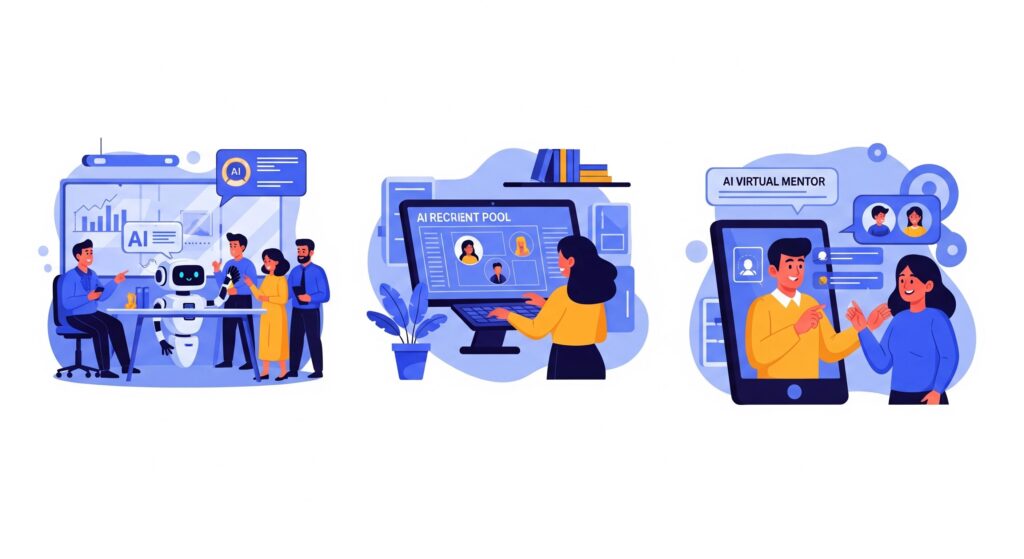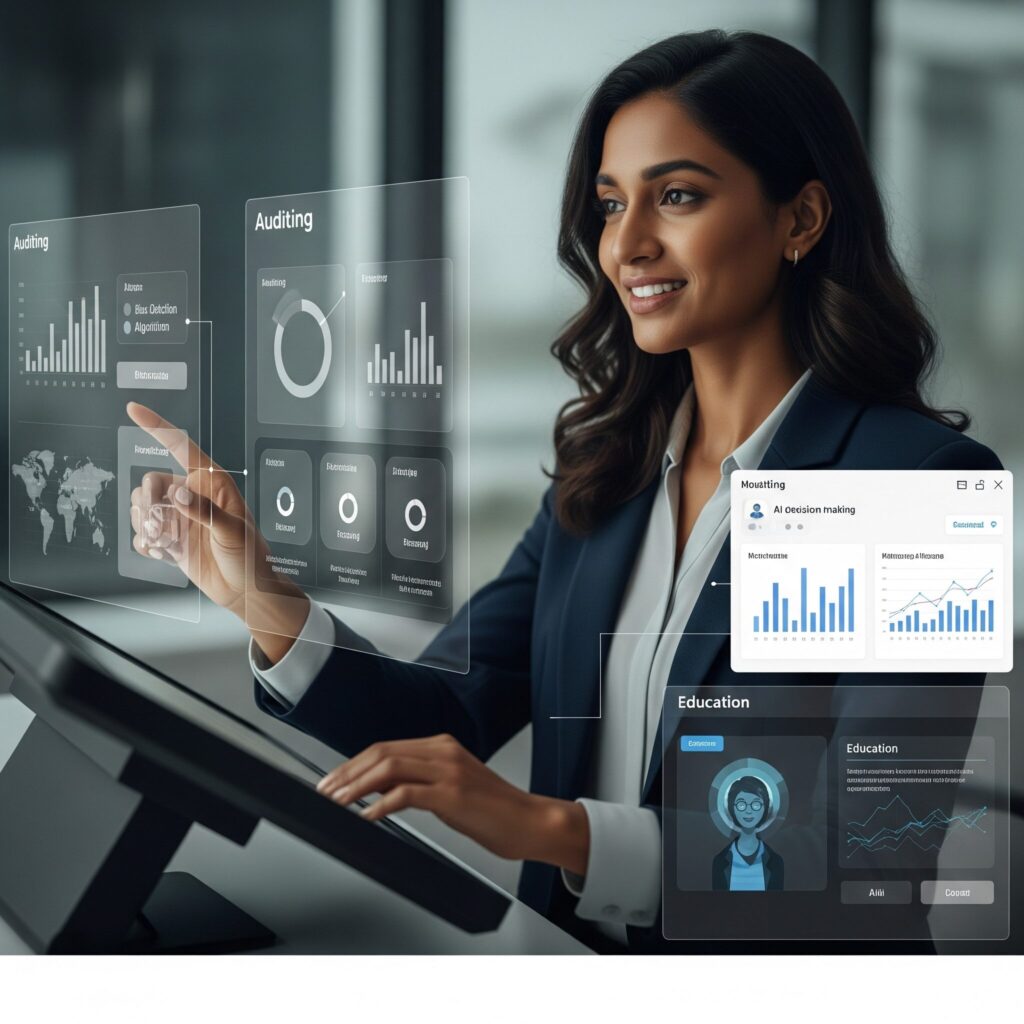Blog
We hear the terms Artificial Intelligence , Machine Learning , and Data Science almost daily. From facial recognition on…
by WeCloudData
February 4, 2025
Blog
The future of hiring is automated. Artificial Intelligence has become a crucial factor in nearly every hiring decision: 87 percent of businesses globally rely on AI-driven tools daily, and 99 percent of Fortune 500 companies automate at least one hiring step. Understanding how artificial intelligence is changing the hiring process is essential for anyone working in HR. Because the truth is, it’s not just about automating administrative tasks. It’s about redefining decision-making. Let’s explore the three ways AI reshaping HR & changing the hiring process with WeCloudData.

One of the three ways AI reshaping HR is AI Algorithms. AI is no longer just a support tool in recruitment. Today’s large language model (LLM) powered applicant tracking systems (ATS) don’t just store resumes; they rank them. Candidates are filtered based on keyword matches, degree titles, and inferred skills, long before a human recruiter ever gets involved.
According to Insight Global’s 2025 survey of over 1,000 U.S. hiring managers, 99% already use AI for screening, and 98% say it speeds up their shortlists.
If a candidate takes a nontraditional career path, has a caregiving gap, or frames their achievements in unexpected language, the algorithm may flag them as irrelevant. For example, if a job description asks for a “rock-star problem-solver,” and a candidate instead writes “skilled at resolving complex issues,” the system may not make the connection, and that résumé might never be seen. This isn’t just a technical issue; it’s a strategic blind spot.
AI recognizes patterns in historical data, so if your history carries bias, the system will accelerate it. Research on Algorithm-facilitated discrimination from Dr Natalie Sheard has found AI reshaping hiring systems may “enable, reinforce and amplify discrimination against historically marginalised groups”. In her interview with ABC Radio National’s Law Report, she shared that “robo-interview” tools and CV scanners can perpetuate discrimination against women, older candidates, people with disabilities, and non-native English speakers.
One example given was the AI hiring tool (now-defunct) system at Amazon that devalued resumes that mentioned “women’s.
This isn’t just an HR ethics issue anymore; it’s entering the courtroom. In the U.S., a federal judge recently allowed a class-action lawsuit against Workday Inc. to move forward, alleging its recommendation engine systematically discriminated against applicants over the age of 40.
This decision sets a powerful precedent: employers (and their service providers) can be held accountable when AI hiring tools result in unfair or unequal outcomes.
AI bias belongs in HR, not just IT or the law. In terms of ethical hiring, people leaders are the first line of defense. This is where to begin:
Audit Your Tools: Request information from your ATS and HR tech providers about the data they use, how their models were trained, and how they reduce bias.
Demand Transparency: Reject “black box” models. A system shouldn’t make decisions if it can’t justify them.
Keep Humans in the Loop: Skilled recruiters should always be able to review automated decisions. AI can assist, but HR is still responsible.
Educate your team: Give your TA and People Operations teams a foundational understanding of AI so they can make the appropriate inquiries and push back when necessary.
Many modern screening platforms can predict a candidate’s “culture fit” based on information such as video interviews, vocal tone, typing speed, or even emojis. AI tools aren’t just filtering resumes anymore. The objective is to evaluate soft skills at scale, such as confidence, enthusiasm, and teamwork.
But here’s the catch: these signals are often unreliable and biased.
Facial analysis tools have different results based on the candidate environment and the quality of the gadgets being used. For example, candidates who had ring lights or high-quality webcams had an unfair advantage, while those who didn’t had their status unfairly diminished. Similar to this, systems that use vocal cue analysis may favor candidates who are outgoing and talk quickly while discouraging those who have accents, disabilities, or just have different communication styles.

HR teams should concentrate on structured, evidence-based techniques rather than relying on AI to make educated guesses about a candidate’s cultural fit based on surface characteristics:
Despite the flaws of three ways AI reshaping HR and in general, AI isn’t going anywhere. And frankly, it shouldn’t.
When applied thoughtfully, AI can reduce administrative overhead, streamline candidate sourcing, and uncover hidden talent that might otherwise go unnoticed. 93% of hiring managers agree: AI is valuable, but human judgment remains irreplaceable. It’s a tool, not a decision-maker.
Beyond the three ways AI reshaping HR, the real challenge lies in how we deploy it in HR team preparation for AI in recruitment—with guardrails, transparency, and a strong ethical compass. That’s where HR leaders must step in.
So, how do we move forward? What is the future of HR technology?
If you’re grappling with these questions about AI-driven hiring solutions for HR teams or planning for your HR tech roadmap in 2026, you won’t want to miss the People First AI Microsummit on July 30, 2025. The AI summit will bring together the voices shaping the future of HR and technology.
This one-day event brings together leading voices in HR and AI to help you navigate the rapidly shifting talent acquisition landscape and HR technology trends. Whether you’re a People & Culture lead, Talent Director, or AI-curious tech exec, this event is for you. It is designed to deliver practical insights with a human-first lens.
Featured Sessions Include:
1. A keynote on the evolving role of AI literacy in the workplace
2. How to align AI adoption with business goals and people priorities
3. The AI Strategy Canvas: A step-by-step framework tailored for HR teams
4. Strategies for integrating AI with R&D and organizational development
Meet the Experts Leading the Conversation:
👉 Reserve your seat: https://microsummit.weclouddata.com/2025-hr-tech 📅July 30 at 09:30 (UTC−05:00) | #PeopleFirstAI2025
Let’s not just adapt to AI—let’s lead it with intention, ethics, and equity.
"*" indicates required fields

WeCloudData is the leading data science and AI academy. Our blended learning courses have helped thousands of learners and many enterprises make successful leaps in their data journeys.
"*" indicates required fields
Canada:
180 Bloor St W #1003
Toronto, ON, Canada M5S 2V6
US:
16192 Coastal Hwy
Lewes, DE 19958, USA